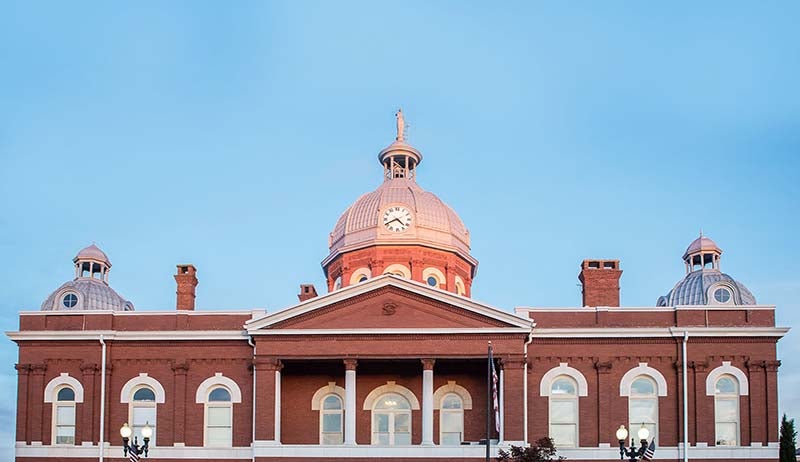Lanier provides history on textile industry
Published 5:11 pm Monday, February 18, 2019
VALLEY — Bradshaw-Chambers County Library began its Making Alabama Lunch and Learn Series with Eddie Lanier speaking on the history of the textile industry in Alabama during the noon hour on Wednesday, Feb. 13. Lanier is the director of environmental services for WestPoint Home and has been with the West Point companies since the 1970s. A large crowd took in the presentation in the library’s Lanier Room.
The principal fiber of textiles – cotton – was growing throughout the Americas when Christopher Columbus arrived to the New World in 1492, Lanier said. “It was planted by the Spaniards in Florida in the 1500s,” he said.
Even though it was used to make textile products throughout the colonial years, it wasn’t until Eli Whitney invented the cotton gin in the late 1700s that cotton became the dominant crop in the South. Before raw cotton could be spun into cloth, the seeds had to be removed. This was a cumbersome, time-consuming process. The cotton gin could do it ten times faster than human hands. This invention paved the way for cotton to become king in the Deep South. It became king in a big way in the first half of the nineteenth century. By 1860, cotton made up 60 percent of the exports leaving the U.S. It was bound for Europe, to be made into finished goods. By the 1840s, most of the cotton grown in Alabama left the port of Mobile headed back to the old country.
Lanier said there were some early efforts to manufacture cotton in Alabama. In 1832, there was a water-powered cotton mill near Huntsville. That same decade, Daniel Pratt of Prattville, Ala. became prominent in the making of cotton gins. By 1844, a large cotton mill had been built on the Tallapoosa River near Tallassee, Ala. For the most part, though, throughout the antebellum period cotton was a crop grown to be exported.
That all changed with the South’s defeat in the Civil War. The entire region was devastated, Confederate money was worthless, and the slaves were set free by the 13th Amendment. Clearly, the plantation lifestyle was gone, and the region had to seek a new future. Rather than growing cotton to be sent overseas, the need was seen to manufacture it here. One of the first major efforts to do this was on the middle portion of the Chattahoochee River in Chambers County, Ala.
“In 1866, two groups of businessmen and planters raised enough money to raise two mills,” Lanier said. “The cornerstones were laid on the same day, on August 1st, first at Upper Town (Langdale) and later in the day at Lower Town (River View).”
One of the mills was known as the Chattahoochee Manufacturing Company and the other the Alabama-Georgia Manufacturing Company. Both mills struggled in the early years. They made a low-quality product known as osnaburg. “They had worn-out machinery and a general lack of knowledge in how to make textiles,” Lanier said. The Panic of 1873 hit the mills hard, and they were closed for a time. They continued to struggle along until two brothers from nearby West Point, LaFayette and Ward Crockett Lanier, purchased the two mills and renamed them the West Point Manufacturing Company.
Though contacts they had in the Boynton Company, located in Boston, they persuaded a textile expert, William Lang of Oldham, England, to come here and run the mill at River View. William’s father, Tom Lang, later came to the U.S. to run the mill at Langdale. They got new equipment, and with the know how to make it, started manufacturing cotton duck, a product that was in great demand. “That turned things around,” Lanier said, “and for the first time, textile manufacturing became profitable in the Valley.”
The connection to Boynton was important in this. “William Wellington, the director, and Horace Sears, the treasurer, played key roles in the growth of the industry. Wellington, Sears and Theodore Bennett were involved along with the Laniers in the building of Lanett Mill in 1892-94.”
Lanier said that the four-story, No. 1 unit of Lanett Mill opened in 1894 with 750 employees and a fast-growing mill village nearby. Things were going so well with the first unit and Unit No. 2 was added in 1900. “At that time it was one of the largest cotton mills under one roof in the world,” Lanier said.
On the north side of the mill, the Lanett Bleachery & Dye Works opened in 1895. “By 1917, it had 150 employees and was one of the largest plants of its type in the U.S.,” Lanier said.
In the early years to textile production in the Valley, the Chattahoochee Navigation Company transported cotton and finished goods from the mills to the railroad in West Point. “The river was unpredictable,” Lanier said. “Sometimes it would be too low to run steamboats and sometimes it would be at flood stage, when it was dangerous to get out on the water.”
The Lanier brothers decided to overcome this by building a short-railroad from West Point to River View. Eventually, the line extended to the AB&A line at Standing Rock to the Central of Georgia line at Bleeker. Known as the CV Railway, this line served the local area well until it closed during the Farley years of the early 1990s, falling just three years of its 100th year.
Company founder LaFayette Lanier died in 1910, and his son, George H. Lanier succeeded him. He would lead the company until his death in 1948.
During his tenure, Shawmut Mill was built in 1908 and Fairfax Mill in 1915.
“Shawmut Mill was the first local mill to be run entirely on electrical power and not water power,” Lanier said. “Fairfax Mill was built for the purpose of being a towel plant. It became known as Towel Town when the company purchased Margerison & Co. and the patent to Martex towels.”
By the 1920s, the Valley had five distinct mill villages in Lanett, Shawmut, Langdale, Fairfax and River View. “Village life was great for the families moving here,” Lanier said. “There were great recreational opportunities, theaters for entertainment, schools, churches and stores.”
Lanier said the principal growth period for the Alabama textile industry took place in the 20-year period from 1889 to 1909. “A total of 70 mills were built,” he said. “By 1916, there were 16,000 textile workers in Alabama.”
In 1897, a future governor of the state, Braxton Bragg Comer built a mill in Birmingham’s Avondale neighborhood. He called it the Avondale Mill. He’d later build mills in Sylacauga and Alexander City. Russell Mills started in Alexander City in 1902. “Ben Russell was an amazing guy,” Lanier said. “He eventually became the world’s leading manufacturer of athletic apparel.”
During the growth period of the textile industry, Fort Payne, Ala. became known as the Sock Capital of the World. “It was said that one of every eight pairs of socks in the world had been made in the hosiery mills in Fort Payne,” Lanier said.
The Pepperell part of WestPoint Pepperell preceded the West Point part. “They started in Biddeford, Maine in 1850,” Lanier said. “They eventually looked south and with Alabama Power expanding looked for sites in this state.”
One of the sites they chose was in Opelika after it was agreed to build Saugahatchee Lake to supply water to the new mill.
“By 1962, there were 125 textile plants and 40,000 textile workers in Alabama,” Lanier said. “It was huge in the state’s economy at that time. One out of every five workers and 25 percent of the electricity consumed in the state was by cotton mills. Cotton mills were consuming more cotton than the state would produce.”
WPMC and Pepperell Manufacturing merged in 1965. In celebration, the company announced that two new mills would be built off of I-85 in the Valley. They would be named in honor of the two presidents at the time of the merger, Joseph L. Lanier for WPMC and Homer M. Carter for Pepperell.
Business continued to flourish for WestPoint Pepperell. In 1998, the company acquired textile giant J.P. Stevens. That made the company the largest producer of sheets and second largest producer of towels in the world.
Unfortunately, textile production was booming overseas. Foreign production had the huge advantage of cheap labor. “By the late 1990s U.S. textiles couldn’t compete with foreign plants,” Lanier said. “Avondale Mills folded in 2006, and shortly after that Tallassee Mills closed. It had been one of the oldest continuously operating mills in the U.S. All of the mills had closed by 2009. At one time, Fort Payne had over 100 hosiery mills. There’s still around 20, but it’s not like it used to be.”
Carpet manufacturers are still doing well in the U.S. “Transport costs make it less profitable to do it overseas,” Lanier said.
Lanier believes this didn’t have to happen to U.S. textile production. “They could still be here,” he said. “Some really bad decisions were made in closing these mills.”






